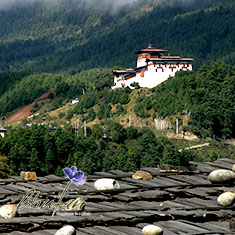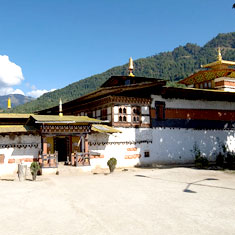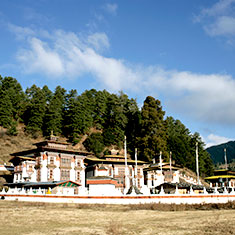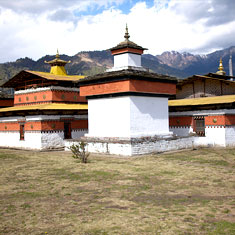
Bumthang
Bumthang is often known as the ‘land of gods ‘in Bhutan. There are plenty of ancient temples and holy places to visit in Bumthang. This region that spans from 2,600-4,500m is the religious heartland of the nation and home to some of its oldest Buddhist temples and monasteries. Tales of Guru Padmasambhava and the tertons (religious treasure-discoverers) still linger in this sacred region. The district is sub-divided into four blocks of Chokhor, Chumey, Tang and Ura. The valleys are broad and gentle, carved by the ancient glaciers. The wide and scenic valleys draw a large number of tourists each year.

Jakar Dzong
The Jakar Dzong or the “Castle of the White Bird” is the dzong of the Bumthang District in central Bhutan. It is located on a ridge above Jakar town in the Chamkhar valley of Bumthang.
Built in 1549 by the great grandfather of the first Shabdrung, the Dzong was initially built as monastery. It was upgraded in 1646, after Shabdrung had firmly established his power. Jakar Dzong is now used as the administrative center for Bumthang valley and also houses the regional monk body.
The other unique feature of the Dzong is a sheltered passage, with two parallel walls, interconnected by fortified towers, which gave the population of the fortress access to water in the case of a siege. The protected water supply is still intact to this day.

Tamshing Lhakhang
Located opposite Kurje Lhakhang on the other side of the river, Tamshing Lhakhang, a major Nyingma monastery located in central Bhutan, was founded in 1501 by Pema Lingpa, the reincarnation of Guru Padsambhava and completed in 1505. It is famous for its collections of paintings which exemplify the region’s style. Its mother monastery is Lhalung in central Tibet. It is one of the few institutions continuing the teachings of Pema Lingpa.
The core missions of Tamshing are teaching the Dharma, performing religious services for the community and educating the young monks under its care.

Kurje Lhakhang
It is a very important monument in the history of Bhutan. There are three temples in a row enclosed by 108 Chortens. A short distance beyond a small ridge is a spring believed to have been taken out by Guru Rimpoche.
Situated before Jambay Lhakhang, Kurje Lhakhang consists of three temples. The one on the right was built in 1652 on the rock face where Guru meditated in the 8th century. Second temple is built on the site of a cave containing a rock with the imprint of Guru’s body and is therefore considered the most holy. The third temple was built in 1990s by Ashi Kesang, the Queen Mother. These three Temples are surrounded by a 108-chorten wall.
Also, a large tree behind one of the temple buildings is believed to be a terma that was left there by Padmasambhava.

Jambey Lhakhang
The Jambay Temple or Temple of Maitreya is located in Bumthang in Bhutan, and is said to be one of the 108 temples built by Tibetan King Songtsän Gampo in 7th century AD on a single day, to subdue the demoness that was residing in the Himalayas. The temple is one of the two of the 108 built in Bhutan. A second is located in Paro, the Kichu lhakhang also built on the same day.
Legend has it that Guru Rimpoche visited the site several times and deemed it exceptionally sacred. Chakhar Gyab, the king of the Iron Castle of Bumthang renovated the temple in the 8th century AD.
One of the most spectacular festivals in the country, called Jambay lhakhang Drup is hosted here. The festival lasts for five days (check with your tour operator to confirm these dates). The highlight of the festival is the fire ritual that is held in the evening where crowds gather to witness the ritualistic naked dance.


